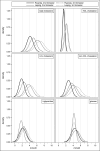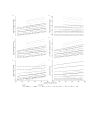Differences in metabolic adaptations during mid and late pregnancy: a comparative cohort study between Rwanda and Germany
- PMID: 40643164
- PMCID: PMC12247662
- DOI: 10.7189/jogh.15.04206
Differences in metabolic adaptations during mid and late pregnancy: a comparative cohort study between Rwanda and Germany
Abstract
Background: While cross-ancestral differences in glucose and lipid metabolism are widely reported in adults, there is a paucity of data on pregnant women during various stages of pregnancy. There is no consensus on what defines normal lipid ranges during pregnancy. Establishing reference ranges is crucial to reduce the risk of missing associated maternal and fetal health issues. Therefore, we aimed to investigate the metabolic profiles of healthy pregnant women and to establish national Rwandan reference ranges for these metabolites.
Methods: We derived the data from two ongoing longitudinal cohort studies conducted in predominantly rural Rwanda and urban Germany (Leipzig), providing repeat data from the second and third trimesters of pregnancy. We measured concentrations of glucose, total cholesterol (TC), high-density lipoprotein cholesterol (HDL), and triglycerides (TG), and estimated their associations with trimesters and cohorts using multivariable linear regression. We estimated the reference ranges using the 5th and 95th percentiles for each metabolic marker.
Results: For Rwanda and Leipzig, lipids and lipoproteins increased across trimesters, except for HDL, which remained equally low for Rwanda and significantly decreased for Leipzig. Concentrations of TC, low-density lipoprotein, and non-HDL were significantly higher in Leipzig compared to Rwanda for both trimesters, while HDL was significantly lower in Rwanda. Rwanda exhibited significantly higher TG levels in the second trimester than Leipzig, although this difference did not persist into the third trimester. Glucose concentrations were significantly higher in Rwanda than in Leipzig for both trimesters.
Conclusions: This is the first representative study investigating lipid and lipoprotein concentrations in pregnant women from Rwanda and comparing them to a European sample. This study shows that lipid, lipoprotein, and glucose concentrations differ by ancestry and stage of pregnancy. The higher TG and glucose concentrations in Rwanda may indicate an emerging burden of metabolic disorders in Africa.
Copyright © 2025 by the Journal of Global Health. All rights reserved.
Conflict of interest statement
Disclosure of interest: The authors completed the ICMJE Disclosure of Interest Form (available upon request from the corresponding author) and disclose no relevant interests.
Figures
Similar articles
-
The establishment of lipid profiles reference ranges during pregnancy: a systematic review and meta-analysis.Reprod Biol Endocrinol. 2025 Jul 28;23(1):110. doi: 10.1186/s12958-025-01450-8. Reprod Biol Endocrinol. 2025. PMID: 40721791 Free PMC article.
-
Continuous subcutaneous insulin infusion versus multiple daily injections of insulin for pregnant women with diabetes.Cochrane Database Syst Rev. 2016 Jun 7;2016(6):CD005542. doi: 10.1002/14651858.CD005542.pub3. Cochrane Database Syst Rev. 2016. PMID: 27272351 Free PMC article.
-
Antiretrovirals for reducing the risk of mother-to-child transmission of HIV infection.Cochrane Database Syst Rev. 2011 Jul 6;(7):CD003510. doi: 10.1002/14651858.CD003510.pub3. Cochrane Database Syst Rev. 2011. PMID: 21735394
-
Antiretrovirals for reducing the risk of mother-to-child transmission of HIV infection.Cochrane Database Syst Rev. 2007 Jan 24;(1):CD003510. doi: 10.1002/14651858.CD003510.pub2. Cochrane Database Syst Rev. 2007. Update in: Cochrane Database Syst Rev. 2011 Jul 06;(7):CD003510. doi: 10.1002/14651858.CD003510.pub3. PMID: 17253490 Updated.
-
Metformin for women who are overweight or obese during pregnancy for improving maternal and infant outcomes.Cochrane Database Syst Rev. 2018 Jul 24;7(7):CD010564. doi: 10.1002/14651858.CD010564.pub2. Cochrane Database Syst Rev. 2018. PMID: 30039871 Free PMC article.
References
Publication types
MeSH terms
Substances
LinkOut - more resources
Full Text Sources
Miscellaneous


